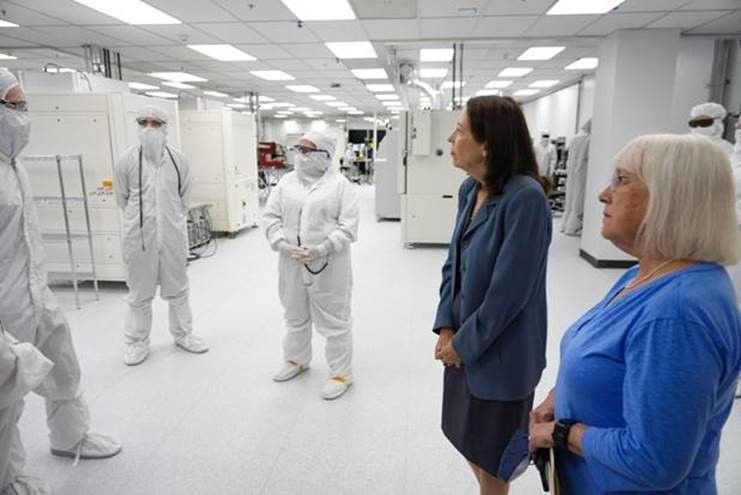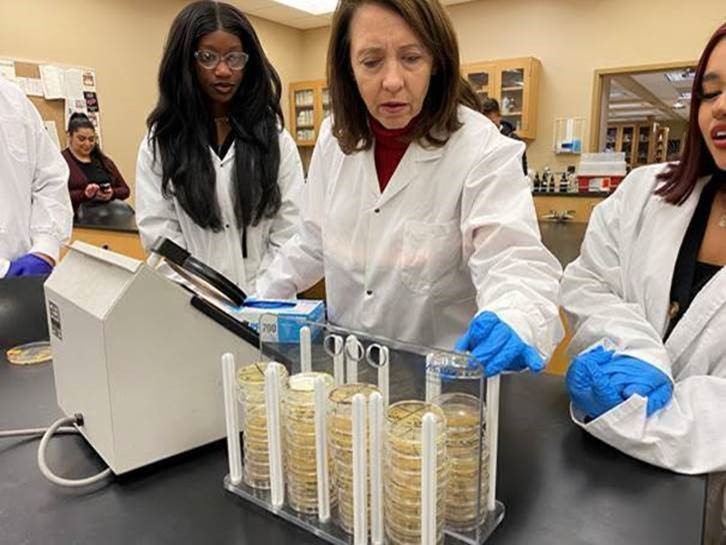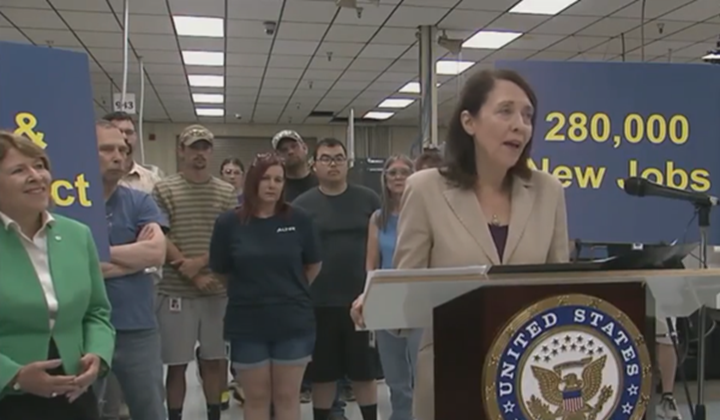Cantwell-Authored CHIPS & Science Act Seeding U.S. Manufacturing, Innovation Resurgence After Just One Year
2,880 new high-wage semiconductor manufacturing jobs already announced in the Pacific Northwest; CHIPS & Science Act unlocking manufacturing and research potential across WA - in places like Seattle, Spokane, Camas, Yakima - and across the nation
WASHINGTON, D.C. – As a chief architect of the CHIPS & Science Act, today, U.S. Senator Maria Cantwell (D-WA), Chair of the Senate Committee on Commerce, Science, and Transportation, celebrated the one-year anniversary of the law designed to spur American research and development, manufacturing, and create thousands of jobs and build a highly-trained workforce.
The law authorized nearly $250 billion for federal research and development, one of the largest five-year investments in U.S. history. The CHIPS & Science bill also funded $39 billion in incentives to spur the construction of domestic semiconductor facilities, $11 billion to augment semiconductor research and workforce development, and established a new 25% investment tax credit for capital expenses in new domestic chips manufacturing facilities and equipment. To date, the United States has received commitments worth over $230 billion to build and expand semiconductor manufacturing from private investments and over 45 community colleges have announced new or expanded chip workforce programs.
“Over the last year, the landmark CHIPS & Science Act seeded a resurgence of American manufacturing, innovation, and entrepreneurship. More than $230 billion invested in domestic semiconductor manufacturing is creating thousands of good-paying jobs,” said Sen. Cantwell. “But our nation is facing a shortage of skilled workers to meet this demand—a gap of 60,000 STEM workers by 2026 in the State of Washington alone—so we must also invest in education, apprenticeships, and training programs.”
Since Sen. Cantwell’s CHIPS & Science Act became law:
- More than 50 new semiconductor projects have been announced across the United States, including four in the Pacific Northwest.
- About 44,000 new high-quality jobs were announced as part of these new projects, including at least 2,880 in the Pacific Northwest.
- The University of Washington received $10 million to train semiconductor workers as part of the U.S.-Japan University Partnership for Workforce Advancement and Research & Development in Semiconductors (UPWARDS) for the Future. The grant was awarded through the National Science Foundation's (NSF) Directorate for Technology, Innovation and Partnerships, one of Sen. Cantwell's priorities in the Act.
- Four new National Science Foundation Regional Innovation Engines in the Pacific Northwest have been selected for funding for further development, built on strong collaborations between Washington, Oregon, and Idaho organizations. Each NSF Engine is a collaboration between local institutions such as universities, nonprofits, and businesses to drive technology innovation and commercialization in key technology areas like semiconductors or to address pressing national challenges like environmental sustainability or access to education.
In the next year, the Department of Commerce will be accepting more funding applications for semiconductor manufacturers to build National Science Foundation Regional Innovation Engines and Department of Commerce Regional Technology Hubs that will promote regional economic development by encouraging collaboration between university research centers, businesses, labor and economic development organizations.
The United States only produces about 10% of the world’s semiconductor supply—and none of the most advanced chips. During the pandemic, a global chip shortage caused supply chain woes and higher costs and threatened America’s global competition. Sen. Cantwell highlighted how consumers in Washington state felt the impacts of the chip shortage when used car prices spiked 40%.
According to the Semiconductor Industry Association, the chip pipeline employs more than 250,000 workers in the United States and supports nearly 1.8 million additional American jobs. By 2030, the sector is expected to add nearly 115,000 new chip jobs – but the United States is predicted to have a shortage of 67,000 workers to fill them. While the State of Washington has the second highest concentration of STEM jobs in the nation — adding more than 6,000 new computer science-related jobs every year — the state graduates about one-half as many bachelor’s degrees in these fields. According to a report by Washington STEM, by 2026, the state will have a gap of approximately 60,000 STEM workers.
The State of Washington has hundreds of apprenticeship programs and centers of excellence that connect students with job training without needing traditional four-year degrees, from industries like aviation and trades to semiconductor chip design and manufacturing.
The CHIPS & Science Act addresses these issues through:
- Manufacturing More in America: Investing $52 billion over five years to support semiconductor manufacturers, attract major companies to build in the United States and protect our American supply chains from future shortages.
- Creating Jobs and Educating and Training More Americans for STEM Careers: Investing $13 billion in STEM education and technical training programs to train more Americans for good-paying careers. The law also includes nearly $2 billion for minority-serving institutions (MSIs) to help build a strong, diverse and innovative domestic workforce.
- Boosting American Research to Lead Global Innovation: Establishing the National Science Foundation's Directorate for Technology, Innovation and Partnerships to accelerate the development and translation of new technologies like artificial intelligence, quantum computing and advanced manufacturing within the United States. The law invests in research at our universities and labs to turn ideas into products faster. The law doubles the National Science Foundation’s annual budget to nearly $19 billion and requires investments in key technologies and workforce development.
Sen. Cantwell was appointed Chair of the 107-member Conference Committee to negotiate the legislation and successfully negotiated and rallied a last-minute bipartisan push to secure the inclusion of historic science research and development investments. The CHIPS & Science Act passed the Senate 64-33 on July 27, 2022, and the House one day later. Sen. Cantwell joined President Biden for the bill signing on Aug. 9, 2022.
While crafting this legislation, Sen. Cantwell used the State of Washington as an example for her Senate colleagues on how the state has a thriving innovation ecosystem because of investments in technology and education.
Chip Workforce in Clark County

In August 2022, Sen. Cantwell and U.S. Senator Murray (D-WA) toured technology company nLight in Camas, Wash., to see chip manufacturing workforce opportunities firsthand. The greater Portland region supports over 30,000 jobs in computers and electronics, with over 2,800 jobs in semiconductor and related device manufacturing in Clark County alone.
STEM Education in Yakima

In November 2022, Sen. Cantwell discussed STEM education opportunities and new federal funding for programs for first-generation college students in the CHIPS & Science Act with Yakima Valley Community College (YVCC) students. YVCC has successfully competed for NSF funds in the past. In 2016, the school received a $448,000 NSF to establish its New Scientist Training program, which provided scholarships, mentorship, and hands-on research opportunities to 52 low-income and first-generation students. Washington schools like YVCC are eligible for NSF funding from the CHIPS & Science Act.
Manufacturing Near Spokane

In August 2022, at the Altek Manufacturing facility in Liberty Lake outside of Spokane, Wash., Sen. Cantwell talked about how the CHIPS & Science Act boosts small towns’ ability to create the next innovation. Eastern Washington is already a candidate for a university research center and could be competitive for manufacturing innovation centers or regional technology hubs enabled by the CHIPS & Science Act, each of which aims to nurture locally-driven innovation regions like Spokane.
###
Next Article Previous Article